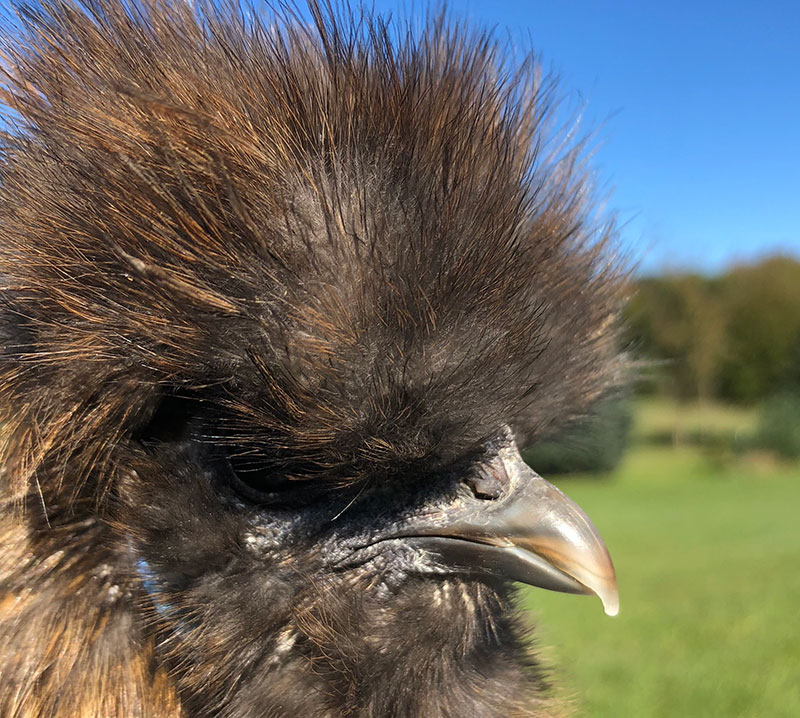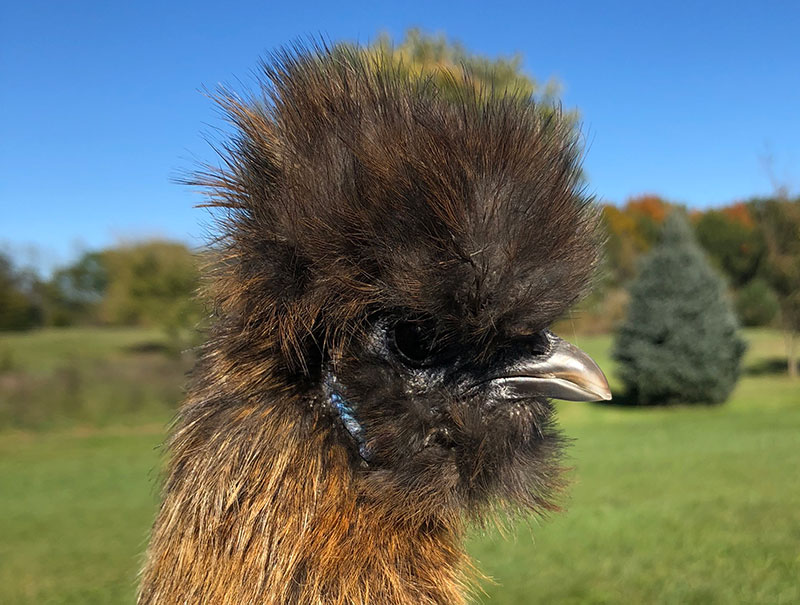
Valeriya behaved like a typical Silkie hen during the summer. Each time I moved our Silkie chicken tractor, I’d find her setting eggs, rocks, rounded clumps of sod or nothing at all. Each time I lifted her to check underneath, she’d emit that soft purr that, for a little Silkie, is the equivalent of a standard hen’s fierce maternal growl. Because her home continually shifted, poor Valeriya never got the opportunity to hatch chicks this year. She gave it her all, however, and that effort included minimal interaction with the rest of her flock and very little physical activity.
When this fall’s below-freezing temperatures began, my nightly Silkie shuffle also started up. Every evening at dusk, I ferry the Silkie flock to a warm wintering pen in our pole barn. In the morning, I bring them back out to their tractor. This continues until the temperatures remain in the high 30s or low 40s all day. At that point, the Silkies move to their winter quarters until the spring thaw.
The first evening the Silkie shuffle took place, my husband, Jae, brought the little birds in as I returned from a school field trip with our youngest son, Bryce. The overnight temperatures remained in the high 40s the following night. A few days later, when the thermometer began its drop below freezing, I began my fluffballs’ ferry service and immediately noticed Valeriya had immense trouble eating. The cause became obvious when I picked her up: Her top beak had grown and was now curling below her bottom beak. Valeriya could barely open her mouth to cluck, much less eat.

The broody hen’s inactivity this summer gave her beak the opportunity to grown unchecked. Without scratching, pecking, eating and her other everyday exertions, nothing kept her beak in a naturally conditioned state. Valeriya needed her beak trimmed.
The Facts on Beak Trimming
Beak trimming has a bad reputation among many backyard poultry owners and hobby farmers. The term brings to mind maltreated factory-farm birds whose top (and, occasionally, bottom) beak is clipped short to prevent fighting, injury and egg loss. While commercial beak trimming does indeed thwart these deeds, it can also interfere with a chicken’s ability to eat, establish rank, preen and—in mixed flocks—mate. A chicken uses its beak to tear off grass, open seeds and otherwise break foods into manageable pieces. Roosters use their beaks to maintain hold on a hen while mating. Males as well as females rely on their beaks to help establish the pecking order of their flock. They also use their beaks to preen: grooming and conditioning their feathers. With a blunted top beak, these activities become close to impossible.
An overgrown beak also prevents these natural actions. Fortunately, trimming a chicken’s beak—to a useable length that doesn’t limit a bird—is simple and takes only a few minutes.
What’s You Need for Break Trimming
- Nail clippers made for a small dog or for a cat (for bantams, you can use human toenail clippers)
- A nail file
- A towel
- A moist cloth or paper towel
- Styptic powder or cornstarch
- Sterile gauze
- Electrolytes
How to Trim a Beak
A chicken’s beak consists of keratin, the same structural protein that comprises hair, claws and hooves. It is easily trimmed following these steps:
- Wrap your chicken securely and snugly in a towel to keep it immobile while you trim.
- Open your chicken’s mouth and observe the coloration of the top beak. The beak becomes darker where the living tissue and capillaries are located. Typically, there is no need to trim a beak back this far, but still be aware of where these are located before you begin to trim.
- If your chicken’s beak is only slightly overgrown, use the nail file to sand it down to a proper length, just slightly longer than the bottom beak. Make sure that you file evenly on both sides to prevent lopsidedness. Do not file back and forth. Rather, sweep the file in the direction away from the bird’s face. Feel for any rough spots and gently file these down.
- If your chicken’s beak is moderately or greatly overgrown, use the clippers to trim it down so that it becomes just slightly longer than the bottom beak. Clip only a tiny bit off at a time, alternating the sides to keep the beak’s end centered. Feel for rough, sharp or pointed edges; use the nail file to smooth these out.
- With the moist cloth or paper towel, wipe the top and sides of your bird’s beak to remove any dust and minuscule beak fragments.
- If you accidentally cut too far into your chicken’s beak and cause bleeding, immediately dip the beak into styptic powder (or cornstarch) to stop the bleeding. Do not wipe the powder off your bird’s beak until you are certain the bleeding has ceased. Use sterile gauze to gently wipe the powder and blood off the beak.
- Add the electrolytes to your chicken’s waterer. Occasionally a bird might become stressed by the trimming procedure or by being “trapped” and immobile inside the towel. The electrolytes help combat any physical symptoms that the stress might cause.
- If you accidentally clip your bird’s beak well into the living tissue, contact your avian veterinarian or your local extension office to seek assistance in proper care for your chicken.

Valeriya graciously permitted me to trim her beak back to size and, with a shake of her feathers, headed directly to the Silkie feeder and ate for several minutes. Satiated, she went right back to her corner and contentedly settled down to brood once again … on nothing. But at least now, she can eat as she pleases.




